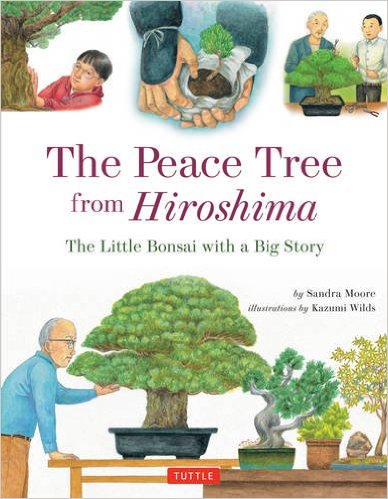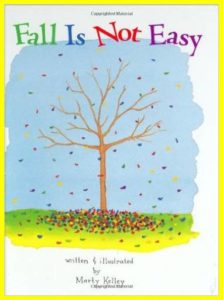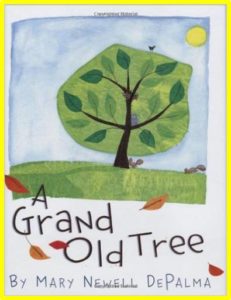 The Peace Tree from Hiroshima by Sandra Moore. Illustrated by Kazumi Wilds delivers a poignant and inspiring story based on true events. The Yamaki family of Japan donated a three-hundred-year-old bonsai (miniature) tree to the United States in honor of our Bicentennial. Their family had cared for this tree for generations. It had survived the atomic bomb that devastated Hiroshima. The gift serves as a testimony to peace and reconciliation.
The Peace Tree from Hiroshima by Sandra Moore. Illustrated by Kazumi Wilds delivers a poignant and inspiring story based on true events. The Yamaki family of Japan donated a three-hundred-year-old bonsai (miniature) tree to the United States in honor of our Bicentennial. Their family had cared for this tree for generations. It had survived the atomic bomb that devastated Hiroshima. The gift serves as a testimony to peace and reconciliation.
Told from the tree’s point of view, the story creates a sense of connection and admiration for the sturdy tree which survived such devastation. [bctt tweet=”The Yamaki’s gift embodies the importance of enemies resolving differences so that peace can reign.” username=”GayleHSwift”] In today’s world rife with terrorism and angry rhetoric, this message is most welcome.
It also offers a chance to talk about world history and how seemingly irreconcilable differences have been resolved between countries or faith communities, ethnic groups, and political parties, etc. This helps place the conflicts of childhood in some perspective to show youngsters, that they too, can pursue peace in preference to fighting or bullying.
The book also includes a glossary and many facts about bonsai trees. The bonsai in the story is over three feet tall. The fact that it has lives for several centuries will amaze kids.
![]() Adoption-attuned Lens This story offers a parallel for adoption. Just as the Miyaki family lovingly nurtured the bonsai for over three hundred years, they placed it into the care of the United States . (While not equivalent to adoption and the significant losses in which adoption originates, the story does convey how the Miyakis continued to care about and be interested in the bonsai even after it was no longer in their family.)
Adoption-attuned Lens This story offers a parallel for adoption. Just as the Miyaki family lovingly nurtured the bonsai for over three hundred years, they placed it into the care of the United States . (While not equivalent to adoption and the significant losses in which adoption originates, the story does convey how the Miyakis continued to care about and be interested in the bonsai even after it was no longer in their family.)
Fall Is Not Easy written and illustrated by Marty Kelly follows the life cycle of a tree through the seasons. It offers an unexpected twist: in autumn, the tree changes, but not in “normal” colors or patterns. Fall Is Not Easy reflects a delightful nod to the free-spirits and creativity of children who delight in coloring outside the lines and in rethinking how things ought to look.
written and illustrated by Marty Kelly follows the life cycle of a tree through the seasons. It offers an unexpected twist: in autumn, the tree changes, but not in “normal” colors or patterns. Fall Is Not Easy reflects a delightful nod to the free-spirits and creativity of children who delight in coloring outside the lines and in rethinking how things ought to look.
Kelly’s simple graphics and very brief text use visual repetition to engage the reader and express the theme that some changes are effortless while others require lots more effort. Each drawing is fundamentally the same yet clearly depicts a seasonal shift. Come autumn, the tree chooses a decidedly non-conformist style which will delight young readers. Yes, we all change. And, thankfully, we all change in different ways and in our own unique ways.
![]() Adoption-attuned Lens This story offers an easy segue into conversations about the variety of families. Like the tree in the book which doesn’t exactly look the way we expect, it is still a tree. [bctt tweet=”Love binds adoptive families together. We may look different or be formed differently from other families.” username=”GayleHSwift”]
Adoption-attuned Lens This story offers an easy segue into conversations about the variety of families. Like the tree in the book which doesn’t exactly look the way we expect, it is still a tree. [bctt tweet=”Love binds adoptive families together. We may look different or be formed differently from other families.” username=”GayleHSwift”]
 Zora Hurston and the Chinaberry Tree
Zora Hurston and the Chinaberry Tree
by William Miller and illustrated by Cornelius Van Wright and Ying-Hwa Hu is a picture book about the great African-American writer. Her mother encouraged her to break through the bonds which restricted women. Still a child when her mother died, Zora heeded her advice and became one of the foremost writers of our country.
Her biography serves as a great example for boys and girls. [bctt tweet=”Girls and boys are equally talented, capable and interested in following their dreams.” username=”GayleHSwift”]Both deserve the chance to pursue jobs, play sports and acquire an education. In terms of opportunities for women and people of color, great changes have occurred since Zorah was a girl. Still, much work remains. Stories like this one help persuade boys and girls that they both benefit when each is able to become their best.
![]()
Adoption-attuned Lens Hurston serves as an example of a woman who broke through barriers. Adoptees may find parallel’s in their own lives as they pursue the talents and aptitudes of their DNA. Many times kids possess abilities and inclinations that are different from the traditional patterns of their adoptive families. It takes courage and the “en-couragement” of their adoptive families for kids to follow their inner compass even if it breaks the family mold. Families can talk about the blessing that their child’s differences infuse into the family. Like a new spice can enhance the flavor profile of a family recipe.
 A Grand Old Tree written and illustrated by Mary Newell DePalma, tells of a tree which grows roots deep into the soil, spreads branches, blooms and fruits and how it offers life-giving shelter, food etc to animals. Child-like illustrations show the seasonal changes which the tree undergoes.
A Grand Old Tree written and illustrated by Mary Newell DePalma, tells of a tree which grows roots deep into the soil, spreads branches, blooms and fruits and how it offers life-giving shelter, food etc to animals. Child-like illustrations show the seasonal changes which the tree undergoes.
Its’ seeds spread wide until they sprout into “grandchildren” whose “arms reach high into the sky.” The story concludes by coming full circle as “The grand old tree slowly crumbled [and] became part of the earth.”
This sweet story introduces children to the concept of the circle of life and how each creature or plant has a beginning and an end. Young readers can see themselves in the seedling at the end of the story who, like them, is at the beginning of life.
![]() Adoption-attuned Lens
Adoption-attuned Lens
Trees often serve as a metaphor for how adoption grafts a new branch to the family tree. This book talks about the roots and the branches as well as the flowers and seeds which the tree produces. This offers a gentle gateway to discuss a child’s roots and his adoption. It could even be used to open conversations about how the seeds scatter to grow in different places. This can lay the ground for future, age-appropriate conversations about biological siblings who are not a part of their adoptive family.
http://wp.me/p4vGHg-Gv

